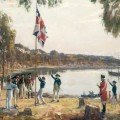 In Victorian London, even in a place as louche and notoriously crime-ridden as the Lambeth Marsh, the sound of gun-shots was a rare event indeed. The Marsh was a sinister place, a jumble of slums and sin that crouched, dark and ogre-like, on the bank of the Thames just across from Westminster; few respectable Londoners would ever admit to venturing there. It was a robustly violent part of town as well – the footpad lurked in Lambeth, there had once been an outbreak of garrotting, and in every crowded alley there were the roughest kinds of pickpocket. Fagin, Bill Sikes and Oliver Twist would have all seemed quite at home in Victorian Lambeth: this was Dickensian London writ large.
In Victorian London, even in a place as louche and notoriously crime-ridden as the Lambeth Marsh, the sound of gun-shots was a rare event indeed. The Marsh was a sinister place, a jumble of slums and sin that crouched, dark and ogre-like, on the bank of the Thames just across from Westminster; few respectable Londoners would ever admit to venturing there. It was a robustly violent part of town as well – the footpad lurked in Lambeth, there had once been an outbreak of garrotting, and in every crowded alley there were the roughest kinds of pickpocket. Fagin, Bill Sikes and Oliver Twist would have all seemed quite at home in Victorian Lambeth: this was Dickensian London writ large.
But it was not a place for men with guns. The armed criminal was a phenomenon little known in the Lambeth of Gladstone’s day, and very little known in the entire metropolitan vastness of London. Guns were costly, cumbersome, difficult to use, hard to conceal. Then, as today, the use of a firearm in the commission of a crime was thought of as somehow a very un-British act – and as something to be written about and recorded as a rarity. ‘Happily,’ proclaimed a smug editorial in Lambeth’s weekly newspaper, ‘we in this country have no experience of the crime of “shooting down”, so common in the United States.’
So when a brief fusillade of three revolver shots rang out shortly after two o’clock on the moonlit Saturday morning of 17 February 1872, the sound was unimagined, unprecedented and shocking. The three cracks – perhaps there were four – were loud, very loud, and they echoed through the cold and smokily damp night air. They were heard – and considering their rarity were just by chance instantly recognised – by a keen young police constable named Henry Tarrant, who was then attached to Southwark Constabulary’s ‘L’ Division.
The clocks had only recently struck two, his notes said later; he was performing with routine languor the duties of the graveyard shift, walking slowly beneath the viaduct arches beside Waterloo Railway Station, rattling the locks of the shopkeepers and cursing the bone-numbing chill.
When he heard the shots, Tarrant blew his whistle to alert any colleagues who he hoped might be on patrol near by, and began to run. Within seconds he had raced through the warren of mean and slippery lanes that made up what in those days was called a village, and emerged into the wide riverside swath of Belvedere Road, from where he was certain the sounds had come.
Another policeman named Henry Burton, who had heard the piercing whistle, as had a third, William ward, rushed to the scene. According to Burton’s notes, he dashed towards the echoing sound and came across his colleague Tarrant, who was by then holding a man, as if arresting him. ‘Quick!’ cried Tarrant. ‘Go to the road – a man has been shot!’ Burton and Ward raced in the direction of Belvedere Road and within seconds found the unmoving body of a dying man. They fell to their knees, and onlookers noted they had their helmets and gloves cast off, and were hunched over the victim.
There was blood gushing on to the pavement – blood staining a spot that would for many months afterwards be described in London’s more dramatically minded papers as the location of a Heinous Crime, a Terrible Event, an Atrocious Occurrence, a Vile Murder.
The Lambeth Tragedy, the papers eventually settled upon calling it – as if the simple existence of Lambeth itself was not something of a tragedy. Yet this was a most unusual event, even by the diminished standards of the Marsh dwellers. For though the place where the killing occurred had over the years been witness to many strange scenes, the kind eagerly chronicled in the penny dreadfuls, this particular drama was to trigger a chain of consequences that was quite without precedent. And while some aspects of this crime and its aftermath were to turn out to be sad and barely believable, not all of them, as this account will show, were to be wholly tragic. Far from it, indeed.
Even today Lambeth is a singularly unlovely part of the British capital, jammed anonymously between the great fan of roads and railway lines that take commuters in and out of the city centre from the southern counties. These days the Royal National Theatre and the South Bank Centre stand there, built on the site of the fairgrounds for an entertainment that was staged in 1951 to help cheer up the blitz-battered and war-weary Londoners. Otherwise it is a cheerless and characterless sort of place – rows of prison-like blocks that house the lesser of the government ministries, the headquarters of an international oil company around which winter winds whip bitterly, a few unmemorable pubs and newspaper shops, and the lowering presence of Waterloo Station – lately expanded with the terminal for the Channel Tunnel expresses – which exerts its dull magnetic pull over the neighbourhood.
The railway chiefs of old never bothered to build a grand station hotel at Waterloo – though they did build monster structures of great luxury at the other London stations, like Victoria and Paddington, and even St Pancras and King’s Cross. For Lambeth has long been one of the nastier parts of London; until very recently, with the further development of the South Bank Centre, no one of any style and consequence has ever wanted to linger there, neither a passenger back in the days of the Victorian boat-trains, nor anyone for any reason at all today. It is slowly improving; but its reputation dogs it.
A hundred years ago it was positively vile. It was low and marshy and undrained, a swampy gyre of pathways where a sad little stream called the Neckinger seeped into the Thames. The land was jointly owned by the Archbishop of Canterbury and the Duke of Cornwall, landlords who, rich enough in their own right, never bothered to develop it in the manner of the great lords of London – Grosvenor, Bedford, Devonshire – who created the squares and mansions and terraces on the far side of the river.
So it was instead a place of warehouses and tenant shacks, and miserable rows of ill-built houses. There were blacking factories and soap-boilers, small firms of dyers and lime-burners, and tanning yards where the leather-workers used a substance for darkening skins that was known as ‘pure’ and that was gathered from the streets each night by the filthiest of the local indigents – ‘pure’ being a Victorian term for dog turds.
A sickly smell of yeast and hops lay over the town, wafting from the chimneys of the great Red Lion Brewery that stood on Belvedere Road, just north of the Hungerford Bridge. And this bridge was symbolic of what encompassed the entire Marsh: the railways, hefted high over the swamps, on viaducts on which the trains (including those of the London Necropolis Railway, built to take corpses to Woking) chuffed and snorted, and across which miles of wagons lurched and banged. Lambeth was widely regarded as one of the noisiest and most sulphurous parts of a capital that already had a grim reputation for din and dirt.
Lambeth Marsh was also, as it happened, just beyond the legal jurisdiction of both the cities of London and Westminster. It belonged administratively, at least until 1888, to the county of Surrey – meaning that the relatively strict laws that applied to the capital’s citizens did not apply to anyone who ventured, via one of the new bridges like Waterloo, Blackfriars, Westminster or Hungerford, into the wen of Lambeth. The village thus became fast known as a site of revelry and abandon, a place where public houses and brothels and lewd theatres abounded, and where a man could find entertainment of all kinds – and disease of all varieties – for no more than a handful of pennies. To see a play that would not pass muster with the London censors, or to be able to drink absinthe into the small hours of the morning, or to buy the choicest of pornography newly smuggled from Paris, or to have a girl of any age and not be concerned that a Bow Street Runner, or her parents, might chase after you – you ‘went Surreyside’, as they said, to Lambeth.







